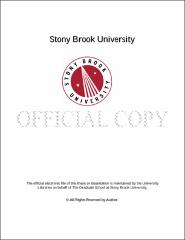| dc.identifier.uri | http://hdl.handle.net/11401/77090 | |
| dc.description.sponsorship | This work is sponsored by the Stony Brook University Graduate School in compliance with the requirements for completion of degree. | en_US |
| dc.format | Monograph | |
| dc.format.medium | Electronic Resource | en_US |
| dc.language.iso | en_US | |
| dc.publisher | The Graduate School, Stony Brook University: Stony Brook, NY. | |
| dc.type | Dissertation | |
| dcterms.abstract | Polyynes are one-dimensional rigid carbon rods composed of alternating triple and single bonds. They have attracted much interest due to their electronic, optical, and physical properties. These carbon oligomers can serve as possible precursors to polydiacetylenes or graphitic ribbons, as subjecting ordered aggregates to heat and/ or irradiation can lead to topochemical polymerization. Furthermore, polyynes can act as models for understanding conjugation, and may be used to predict the properties of carbyne, the linear allotrope of carbon. In this work, model Stille and Cadiot-Chodkiewicz coupling reactions using iodoalkyne substrates were thoroughly investigated. Once optimal conditions were determined for each system, symmetric double cross-couplings to diiodopolyynes were attempted. The Stille reaction was shown to be more effective, as poor selectivity and low overall yield continue to be issues in the Cadiot-Chodkiewicz reaction. The topochemical polymerization of diiodooctatetrayne was also studied, applying a host-guest strategy that aligns the monomers in the proper orientation for controlled polymerization via halogen bonding interactions. Polymerization was monitored using X-ray diffraction and Raman spectroscopy. The spectroscopic data suggest that the morphology of the crystal gradually becomes disordered, as the monomer undergoes partial polymerization. The Raman spectrum of the disordered co-crystals upon irradiation with a 532 nm laser beam indicates the potential conversion of polyynes to graphitic ribbons or fragments. In addition, a synthetic route for an asymmetric diyne with a donor (I) and an acceptor (COOH) end-group was developed, with the goal of preparing a push-pull polydiacetylene. | |
| dcterms.available | 2017-09-20T16:51:56Z | |
| dcterms.contributor | Mayr, Andreas | en_US |
| dcterms.contributor | Goroff, Nancy S | en_US |
| dcterms.contributor | Kerber, Robert | en_US |
| dcterms.contributor | Wachter-Jurcsak, Nanette. | en_US |
| dcterms.creator | Black, Allison | |
| dcterms.dateAccepted | 2017-09-20T16:51:56Z | |
| dcterms.dateSubmitted | 2017-09-20T16:51:56Z | |
| dcterms.description | Department of Chemistry. | en_US |
| dcterms.extent | 203 pg. | en_US |
| dcterms.format | Application/PDF | en_US |
| dcterms.format | Monograph | |
| dcterms.identifier | http://hdl.handle.net/11401/77090 | |
| dcterms.issued | 2013-12-01 | |
| dcterms.language | en_US | |
| dcterms.provenance | Made available in DSpace on 2017-09-20T16:51:56Z (GMT). No. of bitstreams: 1
Black_grad.sunysb_0771E_11565.pdf: 5656222 bytes, checksum: b51635743825c6af8f493c8f6cb63cd1 (MD5)
Previous issue date: 1 | en |
| dcterms.publisher | The Graduate School, Stony Brook University: Stony Brook, NY. | |
| dcterms.subject | Chemistry | |
| dcterms.title | An Exploration of Alkyne-Alkyne Cross-Coupling Reactions and Attempts Towards Controlled Polymerization of Diiodooctatetrayne | |
| dcterms.type | Dissertation | |

